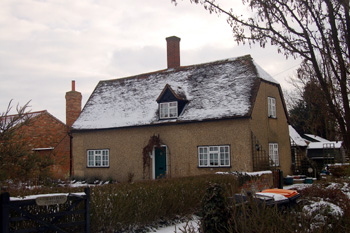298 Cople Road Cardington

Gamekeepers Cottage - 298 Cople Road Christmas Eve 2010
298 Cople Road was listed by English Heritage in May 1984 as Grade II, of special interest. They dated the property to the 17th century. It is built of pebble-dashed roughcast over a timber frame with a clay tiled roof and has a single storey and attics.
We are fortunate that three surveys of the parish of Cardington from the late 18th century survive. The first of these was undertaken in 1782 by James Lilburne. He was the parish schoolmaster and later agent for Samuel Whitbread, who owned large estates in the parish and also the sole Enclosure Commissioner for the parish. He produced a list of all the inhabitants of the parish arranged by house and hamlet [P38/28/1]. This was published, with extensive analysis by County Archaeologist David Baker in 1973 as Bedfordshire Historical Record Society Volume 52.
Since publication a second list has been found [P38/28/2]. It carries revisions up to the year 1789. Sadly neither of these surveys includes a map. Finally, in 1794 Lilburne produced another survey [W2/6/1-3] and this one had a map with a key showing where each house was. One can use this to plot the houses of the previous surveys and this work was carried out by John Wood of Bedfordshire County Council’s Conservation Section in October 1982 [CRT130Cardington29].
The 1782 survey [P38/28/1/2] noted that the occupier was Thomas Estwick and the property was described as a farm. Also living at the property was 67 year old Mary Watford, a widow and a dissenter, that is, a nonconformist in terms of religion. Her maiden name had been Richards and she had been born at “Keasur”, probably Keysoe. She made linen and, presumably, acted as housekeeper. Thomas’ two unmarried daughters, Mary aged 37 and Elizabeth aged 30 also lived at the address, both made lace. The family moved to Bedford on 5th October 1782. On 7th January 1783 Robert Brown, a 25 year old labourer, who had been born in Cardington moved in. His wife was 19 year old Susanna, née Surket, who had been born in Sandy. She spun linen and had smallpox before May 1787. The couple had a daughter, Elizabeth, born on 13th August 1783. The family then moved to another house in the village. A son, William, was then born on 21st September 1785 and, sadly, died, on 20th May 1788. Another daughter, Mary, was born on 29th March 1788. On 5th April 1785 Francis Taylor moved in. He was still in residence in 1794 [W6/2/1-3]
The Rating and Valuation Act 1925 specified that every building and piece of land in the country was to be assessed to determine its rateable value. Cardington, like most of the county, was assessed in 1927 and the valuer visiting 298 Cople Road [DV1/C116/66] found it owned by the Whitbread Estate and occupied by George Warren. The rent is simply annotated “Keeper” suggesting that he was a gamekeeper on the estate and that the rent was taken out of his wages. The present owners, having presumably visited Bedfordshire and Luton Archives and Records Service, have named the house Gamekeeper’s Cottage!
Accommodation comprised a parlour, a living room and a kitchen with three bedrooms above. two kennels, a barn and a barn with a loft over all stood outside and were constructed of brick and tile. The valuer’s comment on the property was; “Very nice. Smart”.
From the mid 19th to the mid 20th century various directories for the county were published every few years. These offer a snapshot of important residents and trades people in each parish. The following list of gamekeepers is taken from directories held by Bedfordshire and Luton Archives and Records Service:
- 1864: Charles Woodcraft;
- 1885: John Stonebridge;
- 1890: George Summerfield;
- 1894-1903: William Burr;
- 1910-1931: George Warren;
- 1936: John Lillywhite.